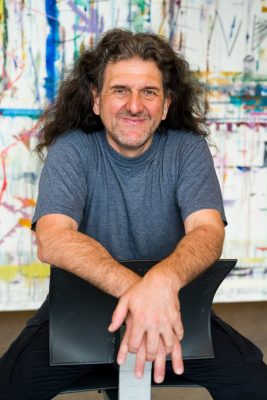Belgium, (Brussels Morning Newspaper) Dr. Ian Biscoe, a professor at the world-famous Eindhoven Design Academy(DAE) in the Netherlands is a kind of UFO in the world of designers. He is a visual and performance artist, director, producer, entrepreneur, designer, and engineer and has degrees in architecture and landscape architecture.

In Eindhoven he functions more like a coach who works with his students in such a way that graduates, through live production, broadcast, and gaming technologies, are able to create custom environments that showcase their projects in a real time visual world powered by Extended Reality (XR) production techniques.
To you politics are ingrained in design. How is this reflected in the work of the students?
“For example, we have a student, Victoria Kaslic*, who is Hungarian. She is trained as a lawyer, but she realized she couldn’t achieve anything under Orban as a lawyer. She made a dance piece that is actually about legal codes. In her introduction, she makes some critical remarks about the current situation in Hungary. Not all students need to make a political or an environmental statement but I am very happy that we have students who are making work that is thinking of design. As designers we don’t always need to make things but what we do need to do is to inform people and to expose things because there is a lot of shit going around in the world and it needs students who are engaged in these things. I tell the students they’ll get much more experience when stepping into a digitally mediated environment. You get the biggest space to play with and everyone needs only 15 minutes. That’s Warhol anyway! ”
How did you come to this conviction ?
“My background is not in art or design. I have always made things or designed things. I always painted, drew, and made things. But actually, I was one of those people that left school at 16 and didn’t go to university because I hated the school system. And after one year I decided I hated to work for other people so I went into business. I was an entrepreneur in Amsterdam when I was 20. I started a series of companies in Europe and the US, mostly in technology. I built different systems and test systems for companies like Boeing, I worked with NASA on the space station and after my aerospace engagement for six or seven years during which I was quite successful, I went to install a mobile communication company. We were quite good in systems for music labels like EMI and Warner and distributing content. Finally, afterwards, I went to study architecture and landscape architecture at Sheffield University in 2009, a relatively recent entry into academic education. My thesis was originally about the disconnect between people inhabiting built environments and the increasingly computerised equipment in buildings. We say for example that buildings are more functional because the heating is controlled and the windows are better insulated but if the people think it is not, the result of all this is that it is dysfunctional. I like to use innovative technology because it is interesting but I often say to students: no, don’t use this technology, use less of this for your project! A candle or a lamp is more interesting than a laser or a huge projector.
Yet modern technology is to be found all over your work?
People have a fear of technology these days because technology is growing so rapidly whereas I also like to say to a dancer or a musician everything you have is technology. The dance you perform, the material you use, the lighting in the theatre, these are all just a form of technology. They only emerged over a longer period of time than all those technologies we have now which are at most 10 or 20 years old. Even students have a fear of technology. They think they understand the internet and technology but they just understand a little bit of it through the lens of several Facebook groups. I always tell my students that unless they are to become a lawyer or a brain surgeon or a nurse, I don’t bother about how good their qualifications are. This can be problematic for the institution because, of course, schools are audited by the government authorities: how many of your people passed, how many got this qualification? As I am also employed by an institution, it may not be the right thing to say but I really believe it! Because when you go for a job as a designer or an artist or a musician, no one ever asks what qualifications you have, what your degree is? They ask about your portfolio! What your views are about the world? They say show me your designs! Time at school is a time to experiment. Don’t bother what other people say. It is really weird to me that we now have students in art and design that if they do really well, some companies will employ them for at least 15 years. I am telling them: no! You need to be doing at least four or five jobs while always thinking about three more things you will or might be doing. My mantra has always been serendipity.
The Persian story of the ‘Three Princes’** is a favorite of mine. If you have a brain and good health then you should just continue to explore and discover.”
So what is the place of the professional designer?
“Don’t misunderstand me. I think it is really nice that we look to people that really want to find out how to make new chairs or tables or pods since I too like to make things. However, I think there is a role for the designer and this is actually what my research is based upon in my role as a kind of choreographer of disciplines. The world increasingly inhabits domains, residing in bubbles, in silos. My life is different. I am always jumping. I like this transdisciplinary approach, this overview, this renaissance of a mankind’s approach to things. This is, of course, a less popular approach since nowadays everyone, starting from the school and parents, says you must specialise, you must focus on a career! Designers are working in material science but they should be thinking of design everywhere. The problem lies within these silos where people all speak different, albeit professional, languages, whether they are environmental scientists, politicians, or psychologists. The general public, the populists, the people that may not understand these issues need to talk to each other but from what I see we don’t have good ways for them to talk with one another, especially when the conversation is about very specific items.”
Dealing with diversity is the problem? You referred once to design as a broad church?
“That’s precisely where the designer’s potential comes in. We need a language of transdisciplinary choreography. I consider it a new language, one that designers can talk about and practice. I use technology to facilitate this and what we are bringing out at this graduate show kind of parallels my own research because management asked me what we should do if we have to close because of COVID? What better could we do than simply present things on a website? We have created a performance or presentation space that is a mixture of technology, theatre, dramaturgy, and scenography. And all of it is in the form of an experiment.
Making new lenses to look all different together? Is this present in European projects?
“The fact is that I think transdisciplinarity is something stupid. When you have multidisciplinarity, you are still looking through the lenses of the different silos when really for me the idea would be that with transdisciplinarity you are making a new lense! You are going to have a scientist, a geologist, a chemist, whatever, coming together and creating a new lense through which they can jointly look together. But you also need to find the constructs so that they can work together.
When it comes to European projects I am a big fan of Europe and not of Brexit which is why I do not live in the UK. I am a European. Before my current post, I was at Fontys University -Tilburg + London. I worked on several different programmes within FP7. These were science-related programs but they were also artistic. We circulated digital network art projects. My work is about how we use the network, not just in buying from Amazon but about how to connect and link these silos of people. So it is about connecting people virtually in real-time in a much better way than we do now with Zoom and other video conferencing systems. The design element is also about how designers can create the language which allows these people to exchange and communicate ideas which often originate from different silos.”
You are disappointed in the new European Bauhaus project…
“Of course the name is rather contentious and full of problems…[I did not think that] coming up with a German philosophy was the best idea. I am not against the concept because it actually fits within my idea of the designer role but I am really disappointed about how it is being set in place. I was in contact early on with Mrs von der Leyen’s assistants and very early in the process was attending meetings and teaming up with others involved. But now I think they are doing the thing in such a way that it appears as if it is a pet project of von der Leyen’s as they start giving out awards like a nice prize for a sculpture in the park.
Of course, Bauhaus has its history. They did a lot of great things too. But we are a hundred years on. We don’t need this Bauhaus. It is now institutional. I have kind of detached myself and have invested any further time in following it up as I think it won’t come up with any solutions.”
How to do it better?
“That’s a problem. Obviously there are other funding programmes tied to this. There is the new green deal, the Horizon Europe. It is nice when there is so much money and programmes but somehow I feel it is too fragmented. Waw, there is 80 billion but when you actually drill out these things, things look differently: unless you are doing a particular kind of research such as cancer where you have 5mio for 3 years and they are giving it to 10 people. That’s fine. But you can’t do much with 500 000 in a multicultural transdisciplinary approach. It is a bit like Washington pork barrels.”



